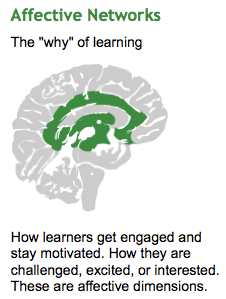Affective Network/Engagement
 Affective networks are specialized to evaluate patterns and assign them emotional significance; they enable us to engage with tasks and learning and with the world around us.
Affective networks are specialized to evaluate patterns and assign them emotional significance; they enable us to engage with tasks and learning and with the world around us.
“Because affective networks work in roughly similar ways across many individuals, we can make some fairly solid generalizations about how people respond to particular situations. Upon the death of a loved one we become sad; startled by a sudden loud noise or dangerous animal we become surprised and scared. However, human beings are not emotional clones. When confronted with the same life event, different people exhibit different kinds and intensities of emotion. In study after study, scientists have shown that people can be sorted into “high” and “low” emotional responders based on their patterns of self-reported emotion, changes in facial expression, or autonomic reflexes (Asendorpf, 1987; Carels et al., 1999; Cole, 1996; Dimberg, 1990; Larsen, 1987). Even animals display this variability (Adamec, 1991; Kalin, 1999; Kalin, Shelton, & Davidson, 2000).
It is easy to spot the outcomes of affective variability. The next time you find yourself in a doctor’s office waiting room, take note of the other patients. Some will start to show signs of agitation the minute their appointment time has come and gone. Others will simply sit back and sigh; they might become upset only if the wait continues for an extended period. Still others will appear to simply accept the situation; they will remain relaxed and calm no matter how long the delay persists. ” (http://www.cast.org/teachingeverystudent/ideas/tes/chapter2_7.cfm)
Image source: http://www.udlcenter.org/aboutudl/whatisudl
Directions:
![]() Download BrainNetworks_handout and use it to take notes as you learn about each of the brain networks.
Download BrainNetworks_handout and use it to take notes as you learn about each of the brain networks.
OR
![]() Go to this Google Doc: BrainNetworks_ElementaryMath
Go to this Google Doc: BrainNetworks_ElementaryMath
![]() Select the following link to the CAST online module and read about affective networks. Continue to the next page “Classroom Examples: Differences in Affect” to review classroom applications of the affective network.
Select the following link to the CAST online module and read about affective networks. Continue to the next page “Classroom Examples: Differences in Affect” to review classroom applications of the affective network.
![]() Discussion
Discussion
Prepare responses to the following questions:
- What do affective networks enable us to do?
- What is the affect of individual differences on affective networks?
- What are the implications of this information for teaching and learning in your classroom?
Leave a comment
Comments 0